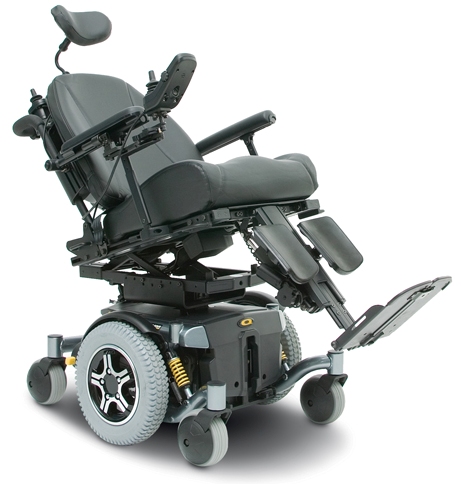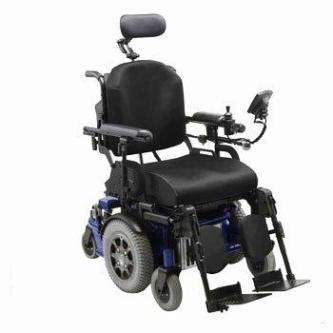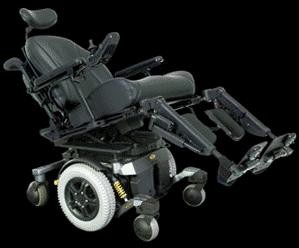More Details
Frame
* The wheelchair features a steel frame which has been built with a low centre of gravity to enable all six wheels to remain on the ground for stability
Seat
* The wheelchair features interchangeable seating systems. The seating system can be adjusted in relation to the power base to change the centre of gravity and help limit the pitching forward effect
The seating systems include:
* Synergy seat - with a curved padded back and seat base board, adjustable for growth and able to be fitted with most seating products. Manual recline and tilt are optional. The seat has a sliding centre of gravity or weight shift tilt system, up to 65 degrees of tilt
* TRU-Balance Power Positioning - includes the following options: power tilt, power recline, power seat lift or elevation (enables the seat to be raised vertically 180mm), and power elevating foot platform or legrests. TRU-Comfort seating is available including a padded, contoured seat and backrest
* The wheelchair can also be fitted with a range of commercially available seating systems and products
Controller
* The controller is programmable and features flush on, off and mode switches, proportional joystick, battery charge indicator and speed control
* It can be mounted on the left or right armrest. A Q-Logic controller is standard
Batteries
* The chair is powered by two 12 volt, 70 amp, deep cycle batteries located within a cartridge style battery box under the frame
* The batteries can be recharged using the off board, 8 amp battery charger
* The battery charging point is located underneath the controller
Centre Wheels
* The mid wheels are 355mm (14") diameter, wide tread and pneumatic
Front and Rear Castors
* 150mm (6") diameter, solid, omni castors on the front and rear
* The omni wheels are spherical and designed to raise and lower to compensate for changes in terrain
Suspension
* It features Active-Trac suspension with extra stability (ATX) and integrated, rear, dual strut suspension with an articulating castor beam
Motors
* The motors are 450 to 700 watt, high torque, four pole hammer motors
* The motors can be disengaged and the chair free wheeled by turning levers, located next to each rear wheel, towards the middle of the chair
* The motors feature Accu-Trac tracking, which assists the wheelchair driving in a straight line on slopes
Armrests
* The armrests are full length, padded, removable and height adjustable
Footplates
* The footplates are solid and flip up as standard. A range of options are available
Legrests
* Standard legrests are swing away and removable with a hanger angle of 70 degrees
* A range of legrest options are available, including elevating legrests
Brakes
* The brakes are electromagnetic, regenerative disc brakes
Considerations
Transport Accessibility
The space allowed on public transport for carrying mobility equipment is an area of 1300mm by 800mm.
Wheelchair spaces
All new Sydney buses feature special 'kneeling suspension' and a ramp to provide easy access for less mobile passengers.
There are spaces for two wheelchairs on the new buses. These will accommodate most manual and electric wheelchairs with maximum length 1250mm, maximum width 750mm, maximum turning circle1500mm and maximum weight 200kg.
For safety reasons, passengers in wheelchairs are advised to face the back of the bus, bracing their wheelchair against the side of the space, applying the brakes and securing the seat belt of the wheelchair.
Wheelchair accessible buses display a blue and white wheelchair sign on the front of the bus, and on the easy access door.
Occupied Wheelchair in a Car
A person sitting in a wheelchair within a car or van requires certification and RTA approval for the wheelchair and occupants restraint system where the wheelchair or occupant are restrained to the vehicle structure. RTA approval is not required for a postural support, such as a harness, that is only attached to the wheelchair and not to the vehicle.
Wheelchair Restraints
When transporting a person in a wheelchair in a car or van, both the occupant and the wheelchair require an RTA approved restraint system. The wheelchair and the occupant need to be separately secured to the vehicle itself.
RTA approval is not required for a postural support, such as a harness, that supports the user in the wheelchair but is not part of the vehicle restraint system.
The use of a headrest is not legally required but strongly recommended. Easily detachable, folding headrests which fit a wheelchair with standard push handles are available. Refer to section Wheelchair, Scooter, Cushions, ramps / Postural Supports - Seating System: Restraint+ Head+Back+Seats
Place Of Manufacture
China and the United States of America
Price Guide
Call supplier for pricing
Price on application from GTK Rehab




 subscribers
subscribers 






